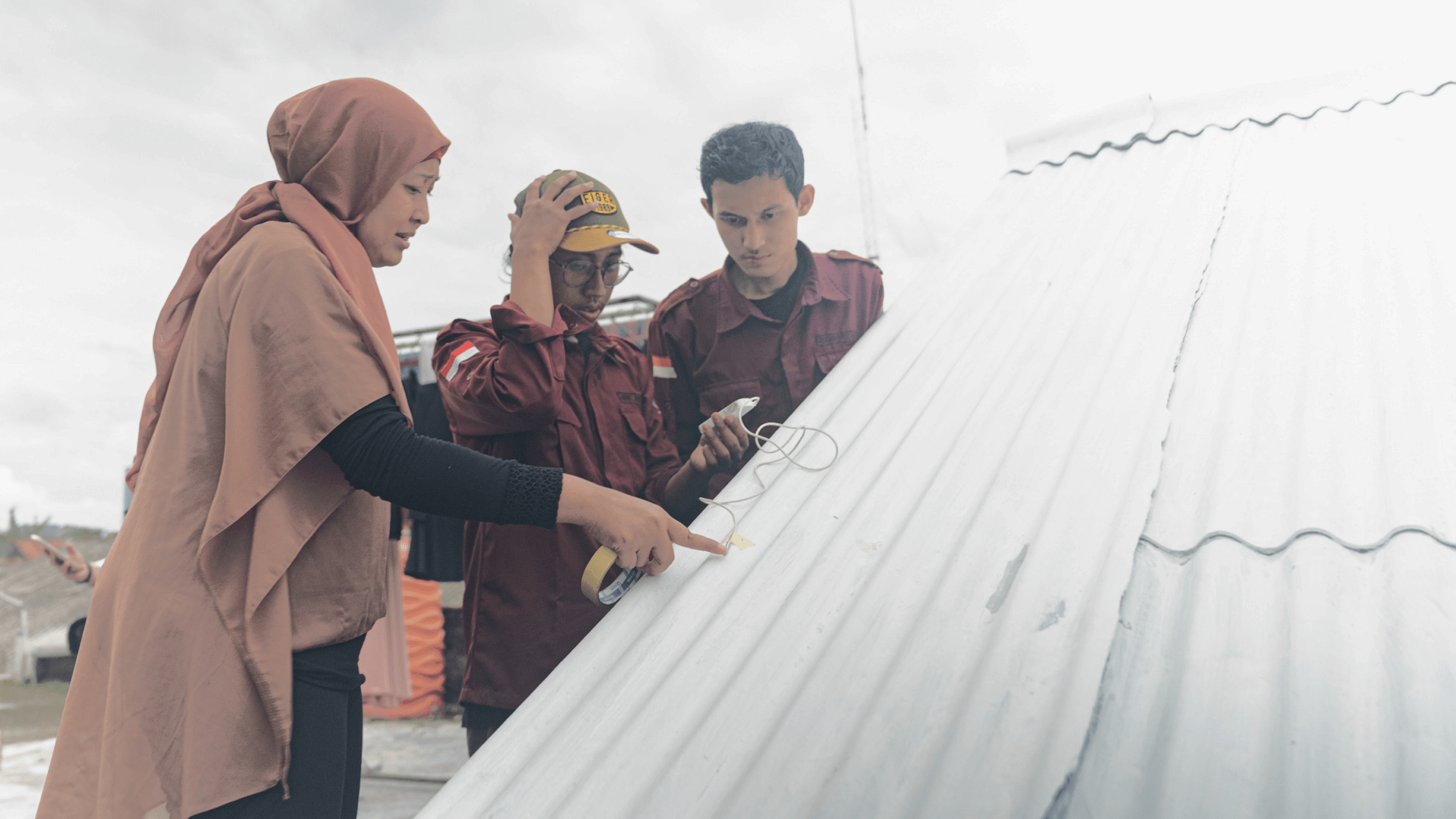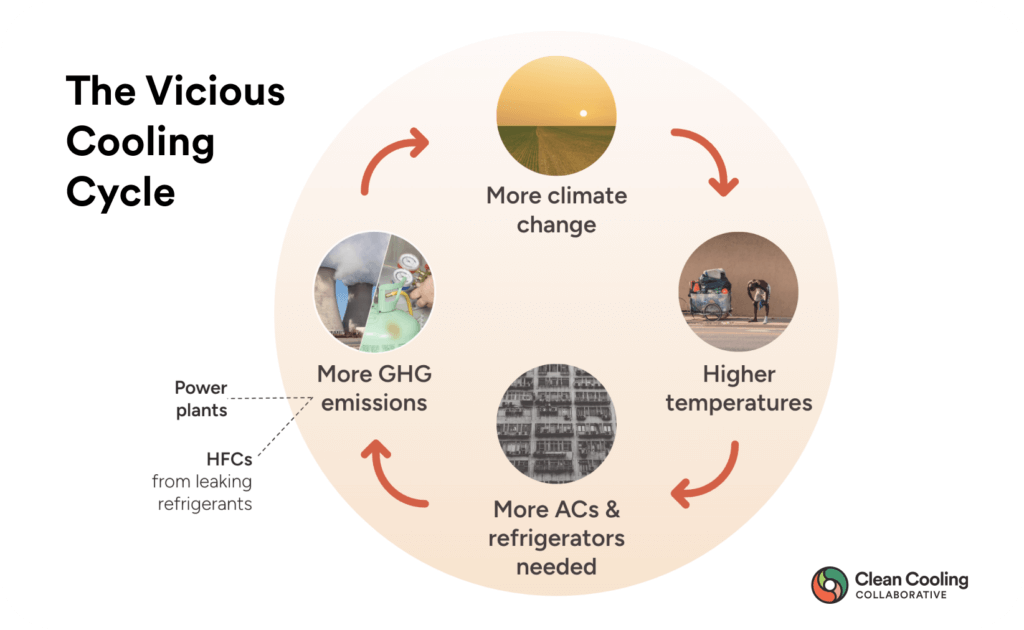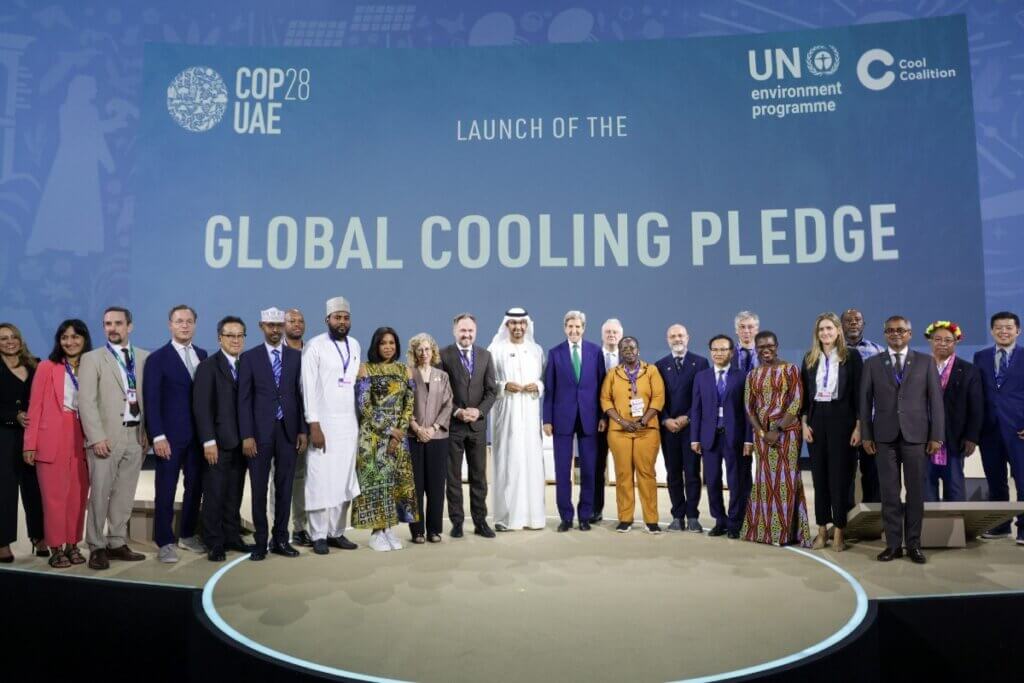
Getting cooling right would save thousands of lives every year and reduce food loss — and could prevent 100 gigatons of greenhouse gas (GHG) emissions by 2050, equivalent to two years of global emissions.
As climate change continues to drive record-breaking temperatures and heat waves, the safety and livelihoods of billions of people are increasingly at risk. Currently, more than 1.1 billion people in rural and urban communities are at risk due to lack of access to cooling, which makes it more difficult to stay healthy, learn and work productively, and keep food and medicines at safe temperatures. One thing is clear: access to cooling is no longer a luxury — it is a human right.
Global energy demand for cooling is expected to triple in the coming decades, according to the International Energy Agency. The roughly 2 billion air conditioning units in use today are already top drivers of global electricity demand. By 2050, 3 billion more units are projected to be in operation. Without energy efficiency improvements, this growth in the number of cooling appliances would lead to as much electricity use as all of China and India today. This increase would further stress electricity grids, which in turn could contribute to more blackouts and brownouts, as well as drive the use of heavy-polluting fossil fuel-based peaker plants.
The growing global demand for cooling contributes to what has been described as the “cooling conundrum.” As the planet gets warmer, demand for cooling goes up. Also, as populations continue to grow, more air conditioners and refrigerators are installed. These cooling technologies add billions of tons of planet-warming greenhouse gas emissions like carbon dioxide and hydrofluorocarbons (HFCs) to the atmosphere due to their energy consumption and refrigerant leakage. “It’s a vicious loop,” says Sneha Sachar, India Cooling Lead for ClimateWorks Foundation’s Clean Cooling Collaborative (CCC). “We cool the indoors, but we warm the outdoors, therefore generating the need for yet even more cooling.”

Over the last few decades, science, policy, diplomacy, and technology have teamed up to respond to the cooling challenge. Collectively, these efforts contributed to the signing of the Kigali Amendment in 2016. This was an amendment to the landmark Montreal Protocol, a global treaty that entered into force in 1989 and banned chlorofluorocarbons (CFCs), greenhouse gases that caused the depletion of the ozone layer. The Kigali Amendment, in turn, committed to a phasedown of the production and consumption of HFCs, which had largely replaced CFCs as the refrigerant used inside air conditioners and refrigerators following the implementation of the Montreal Protocol. If implemented fully, this HFC phasedown could avoid up to 0.4° C in global temperature increases by 2100.
To deepen impact and further reduce emissions, climate leaders have made efforts to get manufacturers to simultaneously incorporate energy efficiency improvements in their cooling technologies as they redesign their production lines and products to switch to more climate-friendly refrigerants that have much lower global warming potential. This unprecedented pairing of strategy for efficiency improvements with the HFC phasedown has set a tone for more collaboration in global clean cooling efforts.
Years later, we continue to see more integrated approaches to tackling cooling. For example, the Global Cooling Pledge was launched and announced at the 28th United Nations Climate Change Conference (COP28) in December 2023. In a major international collaboration, led by the UN Environment Program’s Cool Coalition and UAE COP28 Presidency, more than 60 countries to date have committed to take immediate steps to improve the sustainability of cooling appliances, scale passive and mechanical clean cooling efforts, and increase access to clean cooling for those most at risk in a warming world.
How philanthropy has bolstered progress for clean cooling
Philanthropy has played an active role in advancing clean cooling initiatives. In 2017, 18 leading climate funders recognized an opportunity around the adoption of the Kigali Amendment. Together, these funders established the Kigali Cooling Efficiency Program (K-CEP), which laid the initial groundwork for a cross-cutting, focused approach to advance clean cooling.
Housed at ClimateWorks Foundation, K-CEP initially pooled $52 million to support low-income countries as they paired their HFC phasedown activities with improved energy efficiency opportunities for various categories of cooling appliances. In 2022, the program’s name and strategy areas evolved to become the Clean Cooling Collaborative (CCC), focusing on regions that are projected by the International Energy Agency to have the highest contribution to cooling-sector-related GHG emissions over the next 30 years (China, India, Southeast Asia, and the United States). CCC takes an intersectional approach, working to reduce the cooling sector’s greenhouse gas emissions; increase access to efficient, climate-friendly cooling for heat-vulnerable communities; and continue elevating clean cooling on the international agenda.
K-CEP and CCC’s grants have created an enabling environment for clean cooling to scale, and many of those grants have created ripple effects of impact. For example:
- More than 100 countries have built cooling-specific policies into their national climate strategies or Nationally Determined Contributions (NDCs) — work that will only deepen with the more than 60 countries who have signed the Global Cooling Pledge thus far.
- 30 countries have developed energy efficiency policies or standards for cooling appliances to ensure that every new air conditioner and refrigerator sold meets a minimum level of efficiency. This will help prevent countries in the Global South from becoming the dumping ground for the least efficient products on the market that can no longer legally be sold elsewhere.
- More than 1.1 million square meters of new, solar-reflecting “cool roofs” have been installed globally as part of the Million Cool Roofs Challenge — an area equivalent to 250,000 small household rooftops.
Ultimately, building on the foundations laid by K-CEP, CCC works at many levels of the global cooling agenda, acting as a hub to catalyze research and demonstrations, policy, finance, and market transformation. CCC has created a community of more than 30 grantees from around the world and hosts an annual convening of its grantees and funders to exchange updates on successes, new opportunities, and ways to jointly accelerate change in this space.
These are some of the levers that philanthropy has used to make an impact in the cooling space:
Identifying opportunities and sparking innovation
In the early days of K-CEP, the importance of expanding access to cooling was clear — but just how many people lacked that access wasn’t yet quantified. Some of the initial investment went toward defining the gaps within policy, technology, and finance, along with the opportunities to address them. Building country-specific political and economic awareness became essential for future work to raise cooling access.
K-CEP and its partners also facilitated prizes and competitions that illustrated the efficacy of emerging cooling solutions and incentivized the development of new ones. For example, the Million Cool Roofs Challenge helped scale the adoption of passive cooling strategies, which reduced indoor temperatures by a few degrees Celsius and led to global recognition.
CCC continues this work to transform markets that enable wide-scale deployment of efficient, climate-friendly cooling solutions. The CCC-led Global Cooling Efficiency Accelerator, for example, builds on the work of the Global Cooling Prize (an initiative of RMI, the Government of India, and the United Kingdom’s Mission Innovation) to bring to market super-efficient room AC prototypes that have a five times lower climate impact than the average model today. According to an analysis from RMI, a shift to room air conditioners that deliver this superior efficiency and use more climate-friendly refrigerants can prevent up to 5,900 terawatt hours of electricity per year by 2050 — the equivalent of two times the annual electricity generated within the European Union.
Removing financial barriers to the clean cooling transition
Philanthropy can support the piloting of financial incentives and business models that encourage consumers, service providers, and companies to reach for more energy-efficient options. For example, K-CEP supported the roll-out of new business models like cooling-as-a-service (CaaS), where consumers pay for cooling or refrigeration on a per-unit basis, enabling commercial end users to access efficient technologies without the investment costs. On-bill and on-wage financing programs in Rwanda, Ghana, and Senegal have helped consumers overcome the higher upfront cost of energy-efficient air conditioners and refrigerators.
These days, CCC works to help markets transition to more efficient cooling strategies through the development of pilot demand response programs, which take stress off the electric grid during periods of peak power demand while crediting consumers for their reduced energy use. For example, a groundbreaking demand response program in China holds the potential to save consumers, businesses, and utilities significant expenditures while also reducing the likelihood and duration of power outages. The wider adoption of demand reduction initiatives in China could yield savings of $40 billion over a decade, primarily through the avoidance of having to build and operate additional power plants.
Convening and collaborating
Philanthropy has a unique ability to convene experts from across geographies and sectors. In 2017 and 2018, energy policymakers and Montreal Protocol compliance officers across 147 countries met in philanthropy-supported “twinning” workshops to build bridges between ministries, many for the first time. Then in 2019, K-CEP joined forces with the U.N. Environment Programme to launch the Cool Coalition, which aims to foster collaboration between governments, businesses, and civil society to advance efficient, climate-friendly cooling. These earlier efforts from K-CEP have led to the rapid scaling of best practices, the development of National Cooling Action Plans (NCAPs), and continued cooperation between actors.
“I had been working on energy efficiency for 25 years and it never occurred to me to team up with the ozone people,” said Mirka della Cava, Head of Policy for CCC, about why she spearheaded K-CEP’s support of these early workshops. While agencies continue to benefit from ongoing dialogue on the linkages between refrigerant transitions and energy efficiency, the work that K-CEP supported on the development of NCAPs is an example of how national ozone units successfully prepared approaches to achieving more efficient cooling, often outlining specific measures such as minimum energy performance standards (MEPS) for cooling products.
Now, CCC builds on this legacy of cooperation as they support countries working together toward the common goals articulated in the Global Cooling Pledge.
Influencing policy by defining best practices
Through both K-CEP and CCC, ClimateWorks’ cooling program has helped foster a global ecosystem built upon the sharing of best practices by collaborating with local arenas and learning from their implementation and expertise. The development of model policies by CCC’s grantees offers a customizable framework for countries to establish MEPS. These templates provide best practice guidelines for what actions are needed to transition to more efficient cooling appliances. From there, countries can take into account their region’s markets.
CCC’s support for this emerging community of practice has consolidated best practices and rapidly scaled up the development of effective policy — all in a way that aims to honor a wide range of local contexts around the globe. “You can’t skip over how the local context will embrace or realistically implement best practices,” says della Cava. “CCC and our partners have been asking ourselves: how can we create resources and models that can be picked up, adopted, and absorbed by a diversity of local actors?”
A partnership with Energy Foundation China successfully saw the implementation of new MEPS which resulted in variable speed ACs rapidly scaling in just one year, to represent 98% of the AC market — virtually eliminating its less efficient fixed speed counterparts that use roughly 35% more energy and saving consumers billions in reduced utility bills. Philanthropy-backed efforts have also enhanced the implementation of MEPS, as seen when CCC-supported workshops with Ghana’s Energy Commission led to the improved compliance of its efficiency labeling standard and enforcement for imported cooling products. As countries adopt these best practices, they inspire other regional efforts.
The road ahead
Announced at COP28, the Global Cooling Pledge marked a historic moment to raise international ambition for clean cooling. A growing list of countries (more than 60 to date) and non-state actors have signed the pledge and committed to taking immediate steps to improve the sustainability of cooling appliances, scale passive and mechanical clean cooling efforts, and increase access to clean cooling for those most at risk in a warming world. The cooling sector also released its first-ever stocktake report, outlining the potential pathways to cut cooling-related emissions by more than 60% by 2050 and expand cooling access to 3.5 billion people.

The global momentum behind cooling efforts is an encouraging step, made possible in part by a vast and growing network of climate funders, grantees, and partners around the world. Further progress will take significant additional investment. More funding is needed to build on this momentum, ensure the achievement of global commitments, and scale cooling access in a way that centers on those most impacted by a warming world. To learn more, funders can contact ClimateWorks and explore resources such as CCC’s solution areas, reports, and newsletter.
